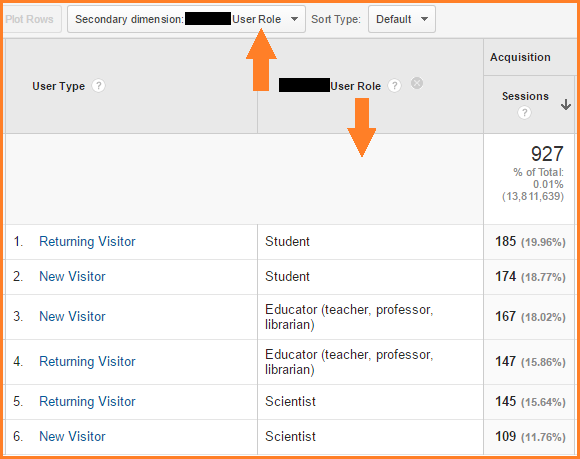Unlock Deeper Insights With Additional Dimension in Google Analytics
With the large area of data offered in Google Analytics, the utilization of secondary measurements can substantially enhance your logical capacities. These additional layers of data offer a nuanced viewpoint that can light up intricate information within your main metrics. By strategically incorporating additional dimensions right into your evaluation, you can unearth useful insights that could or else stay obscure. The ability to translate and dissect customer behavior with higher precision opens a realm of opportunities for improving and optimizing methods performance.
Recognizing Primary Vs. Secondary Dimensions
On the other hand, additional measurements allow you to additional study your primary dimension information. By adding a secondary dimension, you can layer on added information to your key measurement, allowing a more granular analysis. If your primary dimension is the source/medium with which individuals showed up on your website, including a secondary dimension like geographical place can disclose where those customers are situated geographically.
Making Use Of Additional Measurements Efficiently
Properly utilizing additional dimensions in Google Analytics improves the deepness and granularity of information analysis, giving important insights into customer actions and patterns. By including additional measurements along with key dimensions, online marketers and analysts can dig much deeper right into the specifics of user interactions on their sites. Additional measurements allow customers to segment and filter main measurement information better, providing an extra in-depth view of user communications, habits, and demographics. This can be especially useful when trying to understand the influence of certain variables on customer involvement, such as the devices or web browsers they are utilizing, the resources of their traffic, or their geographical locations.
Additionally, secondary measurements enable users to contrast and contrast different data factors within a solitary record, helping with a much more extensive analysis of customer actions patterns. By leveraging additional measurements successfully, services can reveal covert insights, optimize their advertising strategies, and enhance the total user experience on their websites.
Checking Out Common Additional Measurement Mixes
To further assess individual actions and fads in Google Analytics, it is useful to check out common mixes of additional measurements. By combining different additional dimensions, experts and marketers can acquire much deeper understandings into exactly how various variables communicate and affect website efficiency. Some usual second dimension combinations that supply useful insights consist of assessing traffic resources with user places to understand where web site site visitors are originating from geographically and how they discovered the site. In a similar way, integrating landing web pages with gadgets can disclose which pages execute best on different devices, assisting in optimizing the site for better individual experience. Checking out individual habits metrics with additional dimensions such as demographics or passions can help in targeting certain audience sections more successfully. By discovering these usual second dimension mixes, services can uncover hidden patterns, determine opportunities for renovation, and make data-driven decisions to enhance their online visibility.
Using Secondary Measurement in Custom-made Information
Making use of secondary measurements in customized reports enables a much more comprehensive analysis of data in Google Analytics, enhancing the deepness of insights obtained. When creating customized reports in Google Analytics, incorporating secondary measurements can provide a much more thorough sight of exactly how different measurements connect with each other. This attribute makes it possible for individuals to delve much deeper into their information and reveal beneficial relationships that might not be right away apparent.
By using secondary measurements in custom-made reports, users can acquire a much better understanding of their website or application traffic. As an example, incorporating the main dimension of "source/medium" with the second dimension of "landing page" can disclose which landing web pages are doing best for web traffic coming from details sources. This insight can aid marketing professionals optimize their campaigns and boost total conversion prices.

Enhancing Data Visualization With Secondary Measurement
When checking out data in Google Analytics customized records, including additional dimensions not only offers an extra thorough analysis yet also enhances the graph of understandings through data visualization. By including a secondary measurement to your records, you can enrich the way data exists, making it less complicated to determine patterns, fads, and relationships within your internet site's performance metrics.
Additional measurements can help you sector your information additionally, permitting a much deeper understanding of user behavior and communications on your website. This enhanced level of granularity can be specifically useful when trying to isolate details variables that might affect your internet site's efficiency - Secondary Dimension in Google Analytics.

Conclusion
To conclude, leveraging second measurements in Google Analytics enables for a much more comprehensive analysis of information, leading to much deeper understandings and even more enlightened decision-making. Secondary Dimension in Google Analytics. By adding additional layers of details to main information collections, experts and online marketers can discover concealed patterns, patterns, and correlations that supply a granular sight of user behavior and communications. This enhanced degree of insight allows optimization of projects and tailored approaches for specific target market sections, eventually improving performance and conversion prices
On the other hand, secondary measurements allow you to further study your key measurement data. By including a second measurement, you can layer on additional information to your main dimension, allowing a much more granular analysis. If your primary dimension is the source/medium with which users showed up on your site, adding an additional dimension like geographical place can reveal where those customers are situated geographically. By including additional measurements together with key measurements, analysts and marketers can dig much deeper right into the specifics of user interactions on their sites. Additional dimensions enable users to segment and filter primary measurement information further, providing a much more detailed sight of customer communications, Click Here demographics, and habits.